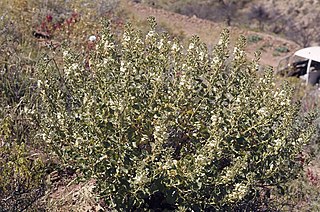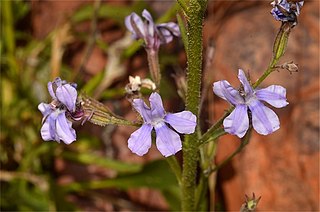
Cupaniopsis anacardioides, commonly known as tuckeroo, cashew-leaf cupania, carrotwood, beach tamarind or green-leaved tamarind, is a species of flowering plant in the family, Sapindaceae, and is native to eastern and northern Australia. It is a tree with paripinnate leaves with 4 to 8 egg-shaped leaflets with the narrower end towards the base, or elliptic leaves, and separate male and female flowers arranged in panicles, the fruit a more or less spherical golden yellow capsule.

Cupaniopsis baileyana, commonly known as narrow-leaved tuckeroo, toothed tuckeroo or white tamarind, is a species of flowering tree in the soapberry family and is endemic to eastern Australia. It is a tree with paripinnate leaves with 8 to 20 narrowly oblong to lance-shaped leaflets, and separate, male and female flowers arranged in panicles, the fruit a more or less spherical red to brown capsule.

Cupaniopsis newmanii, commonly known as long-leaved tuckeroo, is a species of flowering tree in the soapberry family and is endemic to eastern Australia. It is a rainforest tree with paripinnate leaves with 16 to 24 narrowly egg-shaped to elliptic leaflets, and separate male and female flowers arranged in panicles, the fruit a rust-coloured capsule flushed with pink.

Harpullia frutescens, commonly known as dwarf harpullia, is a species of flowering plant in the family Sapindaceae, and is endemic to North Queensland. It is a shrub with paripinnate leaves with 6 to 8 leaflets, white flowers with a pink tinge, and crimson capsules containing 2 seeds with a yellow aril.

Harpullia arborea, commonly known as Cooktown tulipwood in Australia, is species of flowering plant in the family Sapindaceae is native to the Indian subcontinent, Sri Lanka throughout Mainland Southeast Asia and Malesia to Queensland in Australia and the Western Pacific. It is a tree with paripinnate leaves with 6 to 10 leaflets, small pink or pale green flowers arranged in leaf axils or on old woody stems, and orange-yellow to red capsules containing shiny black seeds.

Harpullia hillii, commonly known as tulipwood, blunt-leaved tulip or oblong-leaved tulip, is a species of flowering plant in the family Sapindaceae, and is endemic to eastern Australia. It is a tree with paripinnate leaves, the leaflets elliptic to egg-shaped and papery with the narrower end towards the base, white flowers, and orange capsules containing a seed nearly enclosed in a red aril.

Harpullia alata, commonly known as winged tulip or wing-leaved tulip, is a species of flowering plant in the family Sapindaceae, and is endemic to eastern Australia. It is a tree with paripinnate leaves, the leaflets elliptic with teeth on the edges, white flowers and capsules containing a seed with a yellow to reddish aril.

Goodenia chambersii is a species of flowering plant in the family Goodeniaceae and is endemic to South Australia. It is an ascending shrub with toothed, broadly egg-shaped to round leaves, racemes or thyrses of yellow flowers and oval fruit.

Goodenia ramelii is a species of flowering plant in the family Goodeniaceae and is endemic to central Australia. It is a perennial herb with toothed, elliptic leaves in a rosette at the base of the plant, and racemes of blue flowers.

Swainsona stenodonta is a species of flowering plant in the family Fabaceae and is endemic to the north-west of Western Australia. It is an erect annual herb, with imparipinnate leaves with 7 to 13 narrowly linear or oblong leaflets, and racemes of up to 30 or more dark brownish-red to dark purple flowers.
Swainsona luteola, commonly known as dwarf Darling pea, is a species of flowering plant in the family Fabaceae and is endemic to the eastern Australia. It is a prostrate or low-lying to semi-erect perennial with imparipinnate leaves with usually 3 to 17 narrowly elliptic leaflets, and racemes of 5 to 15 purple, sometimes yellow flowers.

Cupaniopsis foveolata, commonly known as narrow-leaved tuckeroo, white tamarind or toothed tuckeroo, is a plant in the maple and lychee family Sapindaceae found in eastern Queensland and New South Wales, Australia.
Swainsona unifoliolata is a species of flowering plant in the family Fabaceae and is endemic to Central Australia. It is an erect or ascending perennial plant, usually with one leaflet and racemes of about 4 to 15 purple flowers.

Cupaniopsis cooperorum, commonly known as Cooper's puzzle, is a species of flowering plant in the soapberry family and is endemic to Queensland. It is a small tree with paripinnate leaves with 8 to 14 lance-shaped leaflets with the narrower end towards the base, separate male and female, cream-coloured flowers arranged in panicles, the fruit an orange-pink capsule.

Cupaniopsis dallachyi is a species of flowering plant in the soapberry family and is endemic to north-east Queensland. It is a tree with paripinnate leaves with 4 to 14 elliptic to egg-shaped leaflets with domatia along the midrib, separate male and female flowers arranged in panicles, the fruit a brown capsule containing a reddish-brown seed with a brown aril.
Cupaniopsis fleckeri is a species of flowering plant in the soapberry family and is endemic to northern Queensland. It is a small tree with paripinnate leaves with 8 to 10 elliptic to egg-shaped leaflets with the narrower end towards the base, and separate male and female flowers arranged in panicles.

Cupaniopsis serrata, commonly known as smooth tuckeroo, is a species of flowering plant in the soapberry family and is endemic to eastern Australia. It is a tree with paripinnate leaves with 6 to 12 oblong to egg-shaped leaflets with a pointed tip, and separate male and female flowers arranged in racemes, the fruit a more or less spherical capsule containing a seed with an orange aril.

Cupaniopsis shirleyana, commonly known as wedge-leaved tuckeroo, is a species of flowering plant in the soapberry family and is endemic to Queensland. It is a small tree with paripinnate leaves, usually with 6 to 14 wedge-shaped leaflets with serrated edges, and separate male and female flowers arranged in spikes, the fruit a more or less spherical orange capsule containing a seed with an orange-red aril.

Cupaniopsis simulata, commonly known as northern tuckeroo, is a species of flowering plant in the soapberry family and is endemic to eastern Queensland. It is a rainforest tree with paripinnate leaves with 4 to 12 elliptic leaflets, and separate male and female flowers arranged in a thyrse, the fruit a brownish orange capsule.

Cupaniopsis tomentella, commonly known as Boonah tuckeroo, is a species of flowering plant in the soapberry family and is endemic to south-eastern Queensland. It is a tree with paripinnate leaves with usually 6 to 8 elliptic or oblong leaflets, and separate male and female flowers arranged in a panicle, the fruit an orange-yellow capsule with a red flush.


















